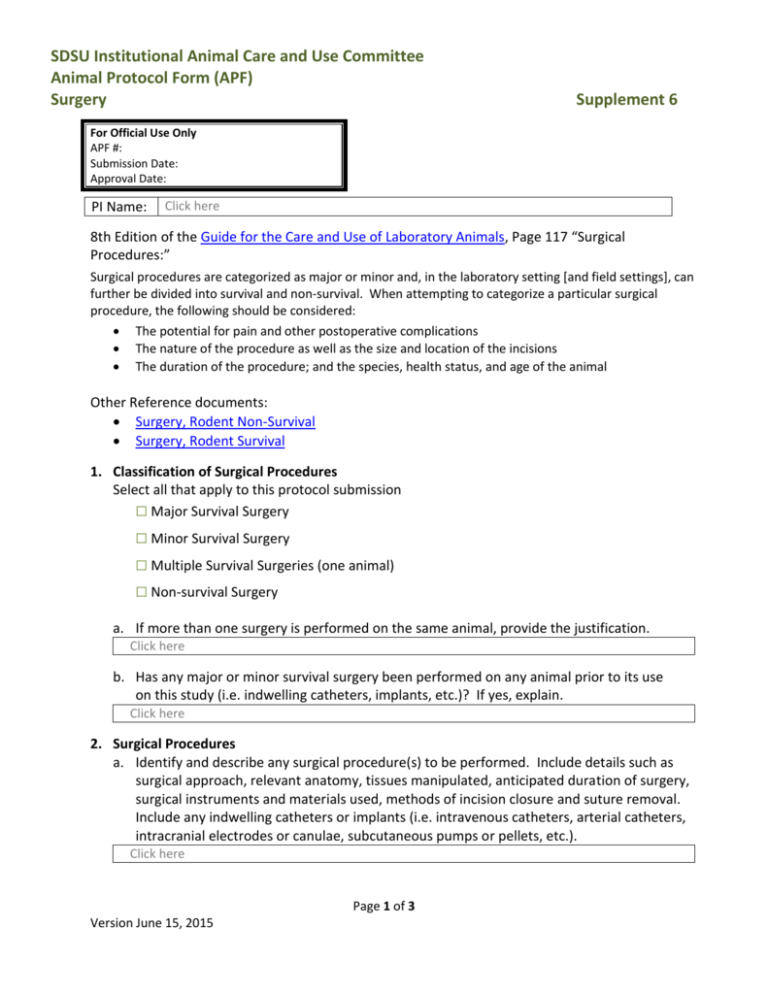Supplement 6 Surgery
advertisement

SDSU Institutional Animal Care and Use Committee Animal Protocol Form (APF) Surgery Supplement 6 For Official Use Only APF #: Submission Date: Approval Date: PI Name: Click here 8th Edition of the Guide for the Care and Use of Laboratory Animals, Page 117 “Surgical Procedures:” Surgical procedures are categorized as major or minor and, in the laboratory setting [and field settings], can further be divided into survival and non-survival. When attempting to categorize a particular surgical procedure, the following should be considered: The potential for pain and other postoperative complications The nature of the procedure as well as the size and location of the incisions The duration of the procedure; and the species, health status, and age of the animal Other Reference documents: Surgery, Rodent Non-Survival Surgery, Rodent Survival 1. Classification of Surgical Procedures Select all that apply to this protocol submission ☐ Major Survival Surgery ☐ Minor Survival Surgery ☐ Multiple Survival Surgeries (one animal) ☐ Non-survival Surgery a. If more than one surgery is performed on the same animal, provide the justification. Click here b. Has any major or minor survival surgery been performed on any animal prior to its use on this study (i.e. indwelling catheters, implants, etc.)? If yes, explain. Click here 2. Surgical Procedures a. Identify and describe any surgical procedure(s) to be performed. Include details such as surgical approach, relevant anatomy, tissues manipulated, anticipated duration of surgery, surgical instruments and materials used, methods of incision closure and suture removal. Include any indwelling catheters or implants (i.e. intravenous catheters, arterial catheters, intracranial electrodes or canulae, subcutaneous pumps or pellets, etc.). Click here Page 1 of 3 Version June 15, 2015 SDSU Institutional Animal Care and Use Committee Animal Protocol Form (APF) Surgery Supplement 6 b. Describe aseptic methods used in the performing of surgical procedures (i.e. instrument sterilization methods, sterile draping, patient preparation, surgeon garb). Click here c. Describe measures to monitor and support patients during surgery such as the monitoring parameters, method of assessing anesthetic depth, and provision of supportive care such as supplemental heat and fluids. Click here d. Will paralytic agents be used during surgery? If yes, describe how respiration, circulation and pain will be assessed. Click here e. For each surgery, list the number of animals expected to undergo the procedure and discuss potential failure rates, associated mortality, possible complications and methods to address these factors. Click here 3. Pre-operative Procedures a. Describe pre-operative procedures including any pre-medication with analgesics, antibiotics, etc., and patient preparations such as fasting. Click here b. Describe measures to monitor and support patients during the pre-operative phase such as the monitoring parameters and the provisioning of supportive care such as supplemental heat and fluids. Click here 4. Post-operative Procedures a. Describe measures to monitor and support patients during the immediate post-operative recovery phase including monitoring frequency, methods of assessing pain and distress, methods of alleviating pain and distress, provision of medications and supportive care such as supplemental heat and fluids. Click here b. Describe the monitoring and support of patients during the days following surgery including monitoring frequency, methods of assessing pain and distress, methods of alleviating pain and distress, provision of medications and supportive care such as dietary supplements, supplemental heat and fluids. Include provisions for after hours, weekends and holidays. Click here c. Procedure/Surgery/Monitoring log sheets must be maintained and will be subject to review by the IACUC, OLAC or Veterinarians upon request. Examples of log sheets can be found: Log Sheet Procedure or Surgery and Log Sheet procedure or Surgery Post-op. Guidance can be obtained from the Surgical Management, Monitoring and Record Keeping Guidelines. Page 2 of 3 Version June 15, 2015 SDSU Institutional Animal Care and Use Committee Animal Protocol Form (APF) Surgery Supplement 6 Click here 5. Anesthesia, Analgesia, Tranquilizers, Other Drugs Please complete the table below and Supplement 4 Surgical Procedure Name of substance administered (i.e. isoflurane, buprenorphine, etc.) Purpose (i.e. anesthesia, analgesia, antibiotic, etc.) Click here Click here Click here Click here Click here Click here Click here Click here Click here 6. Pain, Distress and Endpoints Describe the criteria used to determine endpoints related to surgical complications and/or if pain and distress are unalleviated. Criteria might include immobility, huddled posture, inability to eat or drink, weight loss, ruffled fur, lameness, paralysis, or self-mutilation). Click here 7. Personnel Identify the individual(s) that will perform surgery and describe their qualifications, training, and experience. Note: Also include them in Section A PERSONNEL in the Main APF. Click here 8. Location of Surgery Identify the location where surgery will be performed (building, room #, field location, etc.) Click here Page 3 of 3 Version June 15, 2015






